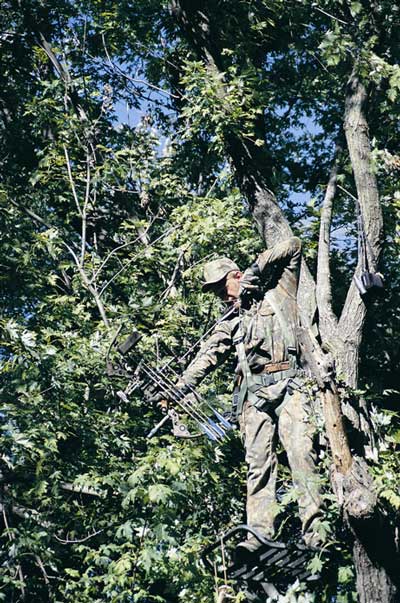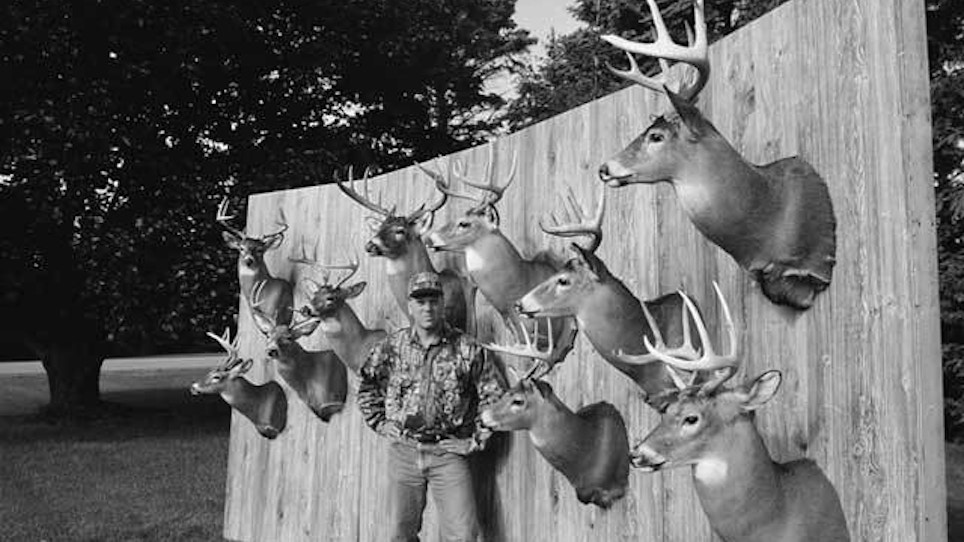To paraphrase the late General George S. Patton, "No one is thinking if everyone is thinking alike." This famous quote couldn't be more appropriate for bowhunters seeking a trophy-class buck.
Mature whitetails may be conditioned to our old textbook tactics, and the only solution may be to deviate from the norm. In the past, I concentrated all my scouting and hunting efforts on areas with rich sign of summer feeding, neglecting the preferred early-season feeds that bucks were craving in their effort to gain weight for the coming rut. That was before I figured out a buck I was bowhunting had patterned my rigid hunting schedule and moved his routine to midday hours when I was not there.
Because I failed to deviate from my tactics, for years I sat without seeing bucks for countless hours during breeding time, ignorant of the fact that they were in a nearby woodlot tending estrous does.
Through experience, my tactics (and my success) have evolved. Today, in my efforts to engage mature whitetails, I now hunt high-calorie feeding sites in early season. In mid season I have extended my hunting time to include the midday hours. During the breeding period, I pursue preoccupied bucks from the ground.
Here is how to effectively hunt during these three distinct times and interpret signs that indicate the transition from one period to the next.
Set Up For Early-Season Feeding Frenzies
It was still dark on October 22nd as I eased through the hardwoods heading for the hemlock stand I had been anxiously waiting to hunt. There was a brisk southwest wind. My plan was to intercept a large buck, one that had been feeding in a cornfield, then returning to his bedding area each morning. I hoped the stand, located close to the bedding area, would allow me to see him during legal hunting hours.
Once settled in, I sat back and waited for dawn. As soon as predawn darkness had surrendered to the early morning light, I was on my feet and looking down the run that connected the buck"s feeding site to his bed.
Suddenly I spotted movement, and the large-bodied 8-point came toward me. In less than a minute, my bow was at full draw and my arrow was airborne. The buck was a beautiful early-season trophy, and I was pleased to find he was packed full of corn — just as I had anticipated.
In summer months, bucks eat foods rich in protein that promote optimal antler development, but their priority changes as the rut approaches. In the early season, bucks will alter their diet from previously preferred, high-protein feeds to foods containing higher energy yields and more calories for fat production for the sole purpose of increasing body mass. That greater body weight and fat build-up will afford them more breeding opportunities and a better energy reserve in the weeks ahead.
During this time, bucks gorge themselves and gain weight on acorns, buckwheat, beechnuts, field corn, sweet corn, and any other high-energy foods they can find during this feeding frenzy. Mature nocturnal bucks can't get enough to eat during the night, so they move to these high-calorie feeding sites during daylight hours. This instinctive feeding behavior offers the aggressive bowhunter his first crack at a trophy.
Early timeframe hunting strategies should concentrate on setting ambush sites that will intercept bucks traveling to and from these preferred feeding areas. Locate primary buck bedding areas by finding trails with large tracks leading from feeding sites back to thick cover. Rubs on these trails will also help disclose when bucks are using them. A rub on the same side of the tree as the feeding site will mean a buck is rubbing in the morning as he returns to his bed, making it an excellent morning stand location.
The final key to success at early season feeding sites is using the wind correctly. A good dose of human scent is intolerable to old bucks, and the will go exclusively nocturnal or abandon the area altogether. Make sure the wind is carrying your scent away from both the bedding and feeding areas at all times.
All good scent control measures must apply when hunting mature bucks, especially in early season before breeding clouds their minds. Finding high-calorie feeding sites and hunting trails connecting primary bedding sites can certainly be the deadly ticket to an early-season trophy.
 Change Your Mid-Season Mindset
Change Your Mid-Season Mindset
As fall progresses and the days become shorter, a buck's new priorities cause different behavioral patterns. Mature whitetails will shift from feeding and weight gain to searching for possible mates. This new drive is strong, and it offers a second distinct timeframe to capitalize on mobile bucks.
The best indicator for this behavioral change is when scraping activity significantly increases and feeding sites aren't nearly as active. This new buck behavior, which I call the searching phase, is very predictable, as movement dramatically increases. Because bucks can be on the move at any time during legal hunting hours, spending additional time in the stand is imperative.
As days continue to shorten, the buck's biological clock keeps ticking. Breeding time is near and opportunities are limited. In late morning mature bucks often become restless and can leave their beds, moving and searching to ensure they are first to find a receptive doe. This instinctive drive to procreate makes midday hunting another excellent time to be on stand and waiting.
I had an enlightening experience several seasons ago. I had been hunting a strict morning and evening schedule for several days over a primary breeding scrape when I made my observation. On Day 7, as I was leaving my stand about 10 a.m., a large oak leaf fell into the scrape. When I returned at 3 p.m. for my evening hunt, the oak leaf was gone. In my absence the scrape had been checked and worked. I figured that the buck was checking the scrape at midday when my threat was gone. The following day I took a beautiful mature 11-point at 11:45 a.m. from that same scrape.
Realizing bucks significantly increase movement during this searching phase, especially in late morning and early afternoon, it is critical for mid-season archers to extend hunting to include the midday hours. I like setting up in high-traffic areas with good scraping sign. I remain mentally focused and keep a positive mendacity to endure the long hours in the stand. I have learned to fight back the urge to leave my stand in late morning by telling myself that a huge buck could emerge from the brush at any moment to check a scrape or scent check a doe bedding area.
Over the years I have found ways for staying focused and in place. The most important is to take whatever measures necessary to remain comfortable in the stand. Having food and warm, waterproof clothing are a must. Many times I have been driven from my stand by hunger or inclement weather. Now I go prepared, my backpack stocked with food, extra clothes, and a rainsuit.
Hunt The Breeding Period
As does begin reaching estrus, bucks will discontinue searching and begin tending receptive females. Signs of this final period include a significant decline in bucks' scraping activity and mirroring does during all hours of the day. When these things start happening in your hunting area, it is time to hit the ground and get busy.
There's no more challenging and exciting way to hunt mature whitetails than ground hunting at breeding time. The stalking hunter has a tremendous advantage during this period of tending. Many stationary treestand hunters may experience no activity in their area.
While I sat in my stand for 10 hours on one cold November day, I saw a doe and two fawns. That evening my dad informed me he saw three bucks chasing a doe just across the street from where I was hunting.
The following day I ground hunted that same area and took a nice mature buck at about 10 a.m. The huge 10-point was so focused on his soon-to-be mate that he didn't have a clue I was after him.
When does are close to estrus, they will attract bucks some six to 12 hours before they are ready to breed. Bucks from far and wide may concentrate around a doe, waiting for the moment she will be receptive. A treestand hunter may sit all day as I did, seeing very little, not knowing that across the field in the next woodlot there is action galore.
When ground hunting mature bucks at breeding time, concealment — visually and scent-wise — is critical. Even though bucks can be preoccupied with breeding and oblivious to their surroundings, does never lose their instinctive awareness and can spoil a promising hunt.
When stalking during the breeding period I scout many different fields, fence rows, and woodlots looking for bucks chasing or shadowing does. Once I've located this breeding activity, I begin stalking the deer into the wind, remembering not to let the does detect me.
As bucks focus does waiting for a chance to breed, this is an opportune time for ground hunters to harvest a trophy. Remember, the buck is extremely vulnerable as breeding is his number-one priority, which clouds his otherwise better judgment.
When stalking, try to split or get between the pair. Once you've separated the buck and doe, your hunt has begun. As the deer are fleeing, pay particular attention to the doe. Mark her trail, stand 10 to 15 yards downwind from her escape route, and get ready. If she is pre-estrus or in estrus, the buck will do anything to get back with her. His ticket to finding her is through his nose. He will frantically scent where she went like a beagle on a rabbit.
As you wait on the doe's trail, have an arrow nocked and a release ready. At any moment the buck could appear, tracking the doe and offering a broadside shot. If you get into this situation, be patient — you could be moments away from the buck of a lifetime.
While no single hunting strategy can guarantee success, thinking outside the box or doing it differently could be your answer. I have found success hunting high-calorie, preferred feeding sites in early season, extending hunting hours to include midday when bucks are searching, and, finally, hunting from ground level. Each offers distinct and separate advantages.






